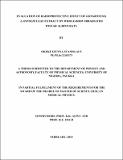UNNSpace Repository
Evaluation of Radioprotective Effect of Gongronema Latifolio Leaf Extract on Whole-Body Irradiated Wistar Albino Rats
JavaScript is disabled for your browser. Some features of this site may not work without it.
| dc.contributor.author | Okeke, Izunna Stanislaus
|
|
| dc.date.accessioned | 2017-03-14T15:30:21Z | |
| dc.date.available | 2017-03-14T15:30:21Z | |
| dc.date.issued | 2017-03-14 | |
| dc.identifier.uri | http://hdl.handle.net/123456789/3915 | |
| dc.description.abstract | The purpose of the study was to evaluate the radioprotective effects of Gongronema latifolio (GL) leaf extract on a whole-body irradiated wistar albino rats. A prospective experimental and cross-sectional design was adopted for this study and it included a control group and experimental group. Part of the control group (normal control NC) was not irradiated neither was it administered with GL extract but the other part (experimental control EC) was only exposed to graded radiation doses (GRDs). In the experimental group, the pre-treatment group (PRT) received GL extract orally before being exposed to GRDs while post-treatment group were exposed to GRDs before receiving GL extract orally. Phytochemical analysis of GL extract was done to re-determine the bioactive constituents of the extract. Physical changes were observed and recorded in all the groups using weight loss as an index. The blood samples of the animal groups were collected before and after irradiation (IR) for following analysis namely liver function test (LFT) {which includes-Alkaline phosphase (ALP), Alanine amino-transferase (ALT), Aspatate amino-transferase (AST)}, and antioxidant enzymes tests like Malondialdehyde (MDA), Glutathione (GSH), Catalase (CAT) and Superoxide dismutase (SOD)}.The result of the phytochemical analysis revealed the presence of the following bioactive agents- alkaloids (3.11mg/g), tannins (2.43mg/g), flavonoids (1.31mg/g), phenols (1.10mg/g) and saponin (0.8mg/g). Body weight of the rats exposed to 6Gy in EC (51g) significantly (p<0.05) decreased when compared to NC (115g) and PRT (70g) but not significantly (p>0.05) different from PST (60g) group. ALP mean levels recorded in rats exposed to 4Gy increased (p<0.05) significantly in EC (74iU/L) when compared to PRT (37iU/L), PST (43iU/L) and NC (39iU/L) group on day 8 after IR. ALT mean level for rats exposed to 4Gy elevated (p<0.05) significantly in EC (50iU/L) relatively to PRT (31.67iU/L), PST (38.67iU/L) and NC (37iU/L) on day 8 after IR. MDA activity levels for rats exposed to 6Gy significantly (p<0.05) increased in EC (70%) relatively to PRT (35%), PST (59%) and NC (36%) on day 8 after IR. For rats exposed to 2Gy, GSH % activities decreased (p<0.05) significantly in EC (26%) when compared to PRT (59%) and NC (69%) on day 8 after IR. For rats exposed to 4Gy, CAT % activities significantly (p<0.05) decreased in EC (31%), PRT (49%) and PST (44%) relatively to NC (79%) on day 8 after IR. For rats exposed to 2Gy, SOD % activities decreased significantly in EC (29.33%), PRT (50.67%) and PST (40.67) when compared to NC (75%) on day 8 after IR. Consequently, the result obtained suggested that GL extract emeroliates oxidative stress induced by ionizing radiation, thus affirming its radioprotective potentials. The result also demonstrated that the extract was more effective in PRT group relatively to PST group | en_US |
| dc.language.iso | en | en_US |
| dc.subject | Radiation | en_US |
| dc.subject | Antioxidant enzymes | en_US |
| dc.subject | Wistar albino rats | en_US |
| dc.subject | Gongronema latifolio | en_US |
| dc.subject | Radioprotective potentials | en_US |
| dc.subject | Phytochemical | en_US |
| dc.title | Evaluation of Radioprotective Effect of Gongronema Latifolio Leaf Extract on Whole-Body Irradiated Wistar Albino Rats | en_US |
| dc.type | Thesis | en_US |
